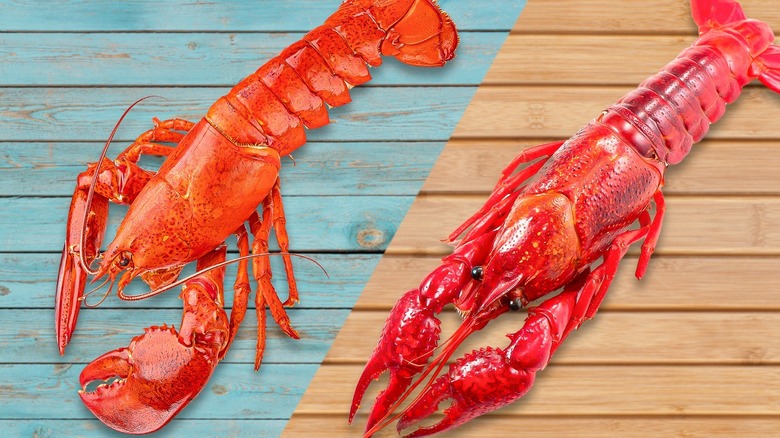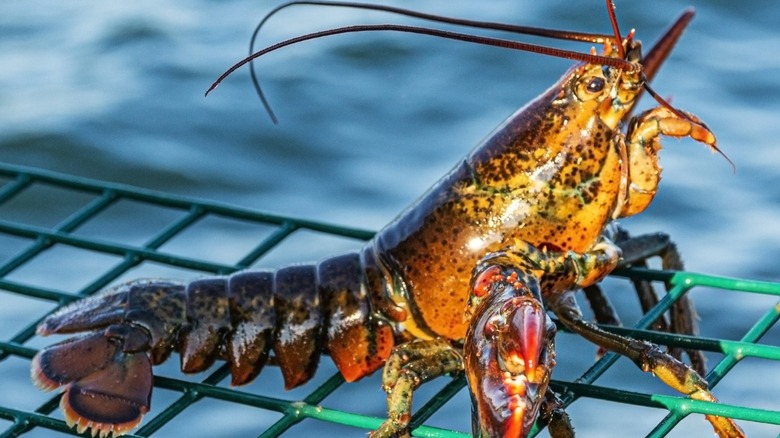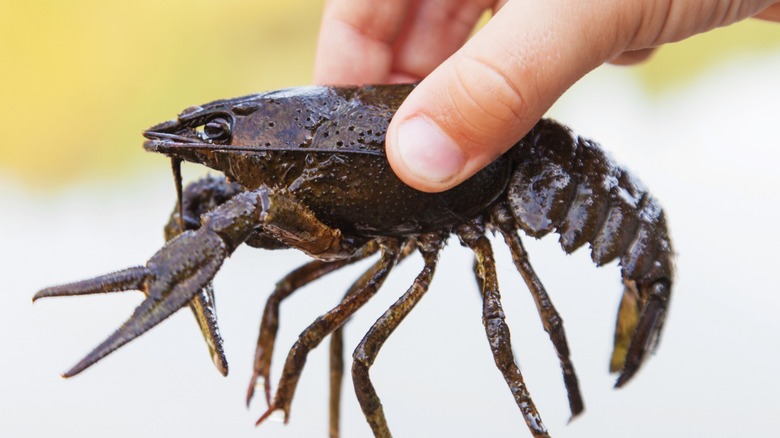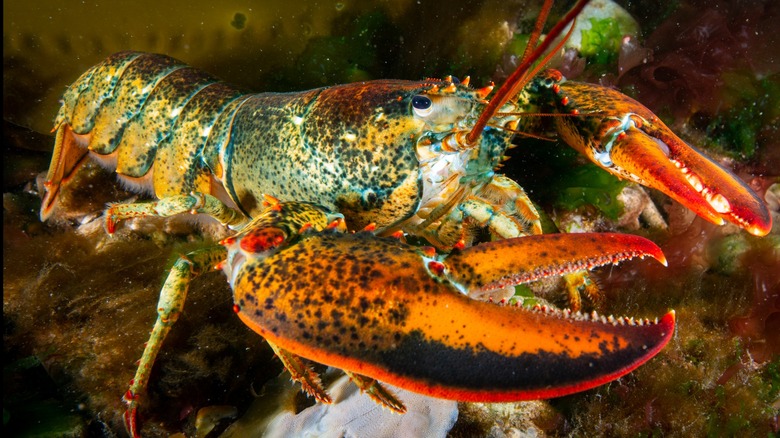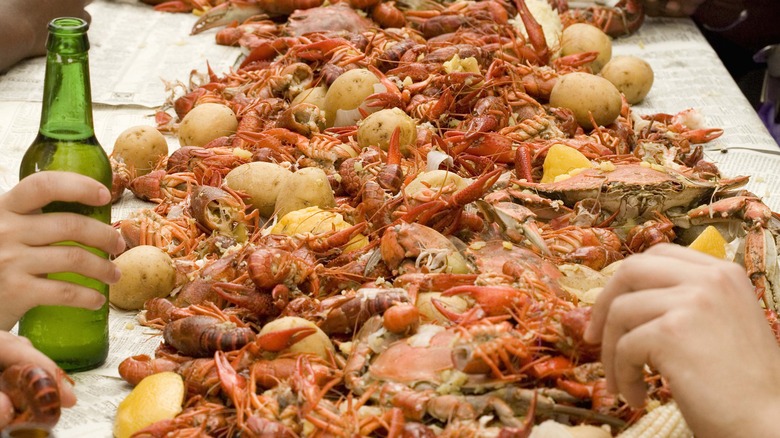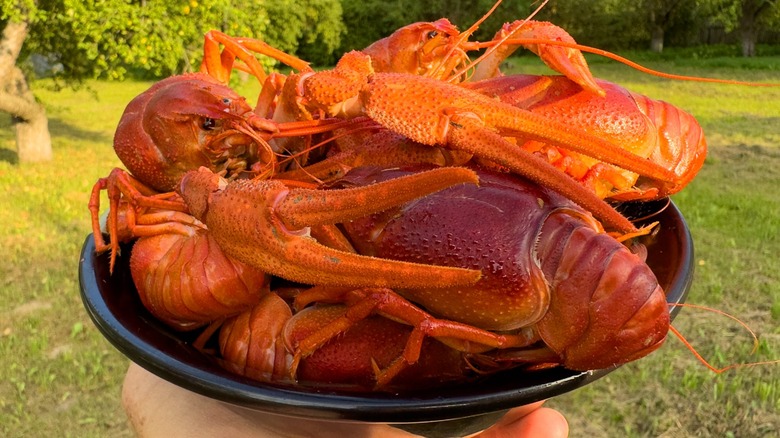The Difference Between Lobster And Crawfish
There's nothing quite like a seafood boil, in which you assemble a tasty selection of crustaceans and enjoy a hands-on affair. Such meals typically incorporate local components, making it easy to craft a large batch fit for a crowd. In the U.S., there are two famous cultural traditions that promote this culinary activity: the New England lobster feast and the Lousiana crawfish boil. Although they often incorporate similar ingredients, the different crustacean base used offers a distinct experience.
So, what is the difference between the two shelled and clawed aquatic creatures? Past their most immediately recognizable difference — size — there are actually a whole lot of disparities. Not only do the respective sea creatures lend themselves to a particular eating experience, but they each align with varying ingredients, too. Throw in different regions of habitation, and there are many culinary renditions of each animal. So, let's dive into the distinctions between these two crustaceans.
What are lobsters?
Lobster is an iconic seafood delicacy that encompasses many different species. The seagoing crustaceans are defined by certain characteristics: The creatures must live in saltwater and inhabit the ocean bottom. Most are greenish brown in life, though they don't all have large claws. Spiny lobsters, for example, only have tiny pinchers; hence, only the tails are eaten. Then, there are additional affiliations, such as langoustines, which may or may not be included under the conventional "lobster" moniker.
However, the most common association with the name is the Homarus americanus, colloquially referred to as the Maine lobster. This species is bright red when cooked and has the iconic sweet and juicy white flesh, which can be found in the claws, tail, and as smaller flavor-packed morsels throughout its legs. The animal's larger size makes it a popular option for steaming, grilling, and boiling, and its meat can also be incorporated into iconic dishes like lobster rolls and bisque. This type of lobster is instantly recognizable and is an indispensable part of America's culinary canon, especially in New England.
What are crawfish?
Crawfish, also referred to as crayfish, crawdads, and mudbugs, encompass a wide variety of crustacean species. Unlike their cousins, the lobsters, these creatures mainly live in freshwater and are much smaller in size — typically only three inches long. They inhabit small bodies of water, like streams and lakes, and hide underneath objects. Unlike the most popular lobster varieties, they're found in multiple hues, with white, red, orange, and even blue varieties.
In flavor, many consider them to be even sweeter than lobster, with a naturally less salty quality due to their habitat. Plus, eating them is a fun and unique experience. Due to their smaller size, it's necessary to put in work to get tiny bits of flesh out, with especially scrumptious bites found in the head. However, some clean the creatures and then integrate them into other dishes, like Cajun crawfish pies, salads, soups, and more. Due to their more affordable cost, these crustaceans are often incorporated into a wide variety of applications, although they do take more time to clean.
Crawfish and lobsters hail from different regions
Crawfish and lobsters have both been consumed by humans for a long time. In the U.S., Native Americans foraged as part of their diet, both in the freshwaters of present-day Louisiana and along New England's coastline. In the latter, lobsters lived ubiquitously and were utilized for fishing in addition to food. Due to their abundance, they quickly became integrated into local cuisine upon European arrival.
Although they didn't become a delicacy until the early 20th century, their more prominent regional status turned them into a widely consumed food. Conversely, crawfish remained relatively obscure until better transportation systems emerged in the 1960s. Today, most crawfish consumption remains in Louisiana, although they're also enjoyed on the Atlantic coastline in smaller quantities.
Most lobsters are caught on the Atlantic coastline, with a small amount of spiny lobsters harvested in California. Internationally, crawfish are also featured in the cuisines of Nordic countries, as well as in Sichuanese Chinese cooking. Meanwhile, lobsters are consumed in coastal regions globally, including the Caribbean and Oceania, with spiny lobsters being popular in the Mediterranean, Asia, and Australia, too.
Crawfish and lobsters have varying culinary uses
Due to their varying sources, lobsters and crawfish have different culinary uses. When it comes to heating applications, steaming is a preferable choice for lobster; however, crawfish is solely boiled. Due to their voluminous tails, lobster meat can be served as an intact piece, as opposed to the smaller chunks of cleaned crawfish. As a result, crawfish is typically enjoyed whole or melded into dishes.
In Cajun cuisine, they're frequently sautéed and featured in étouffée, a rich tomato-based stew with a bit of spice, or stuffed into bread. Meanwhile, in Italy, the meat is integrated into delicious pasta dishes. Lobsters also encompass a wide range of culinary uses. Past the iconic lobster roll, common combinations include pastas — especially macaroni and cheese — dips, soups, and, in the Caribbean, they're typically grilled.
Since lobster tails are often frozen, they're easier to integrate into cuisine further from harvesting areas, hence their frequent appearance in surf turf dinners. Regarding the meat's flavor, the two creatures are similar. Some believe crawfish have a slightly sweeter palate, although it depends on the seafood's precise sourcing and preparation. Plus, there's a whole lot of variation in each species, which only adds to the flavor differences.
Crawfish and lobsters provide different nutrition
Although similar in many ways, the two crustaceans do offer slightly different nutritional value. According to Healthline, lobsters are an excellent source of protein, packing in 27 grams per cup — around 4 grams more than an equivalent serving of crawfish. While low in fat, lobster does contain a high amount of cholesterol, with around 70% of the recommended daily value found in a serving.
Conversely, crawfish sits at a much lower 38% of the daily recommended cholesterol for an equivalent amount. Additionally, lobster is high in omega-3s, fatty acids that, according to Healthline, promote heart health and help prevent cancer. While crawfish also contain omega-3s, lobster boasts a much higher concentration. The two animals also contain different vitamin compositions.
Lobster offers a lot of vitamin B12, which, according to Healthline, is helpful for brain health. Meanwhile, a cup of crawfish contains around 25% of the daily recommended iron serving. WebMD notes that iron plays a role in oxygen circulation, as well as other essential bodily processes. So, enjoy a meal featuring either crustacean; they're both tasty foods worth relishing.
